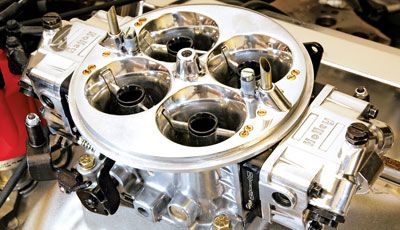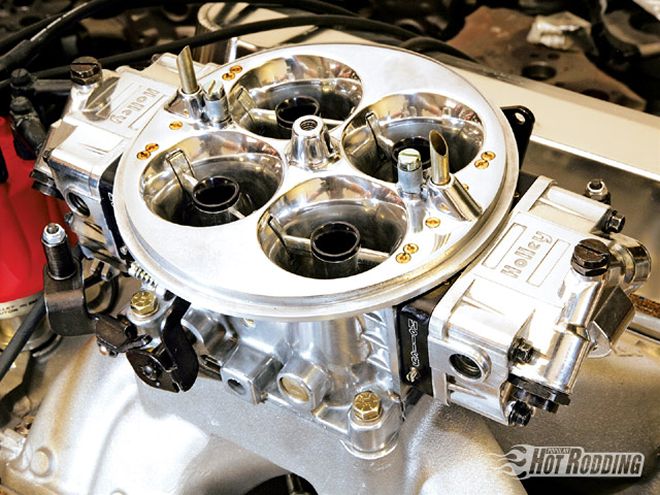
 The Ultra looks like a tricked-out Dominator, but it's built like no Dominator has ever been made before.
The Ultra looks like a tricked-out Dominator, but it's built like no Dominator has ever been made before.
Holley has been manufacturing the revered "Dominator" series of high-capacity carburetors since the first 1,050-cfm units were developed in 1968 to meet the voracious airflow demands of Ford's NASCAR engine program. Based upon Holley's respected 4150 Series of four-barrel carburetors, the 4500 Series Dominator carbs featured up-sized architecture for serious flow. Although the Dominators shared many common parts with Holley's standard four-barrel carb, including the tuning components, metering blocks, and float bowls, the most significant change was a spreading of the bore centers in the main body to allow a substantially increased venturi size and bore diameter. The large main body featured an integral baseplate, and required a manifold with a 5.380-inch square bolt pattern to accommodate its girth. Holley's Dominator quickly garnered the status as the carburetor of choice in racing applications where airflow is at a premium.
Since the Dominator's debut, Holley has continuously refined the Dominator product line. The available flow capacity has grown to as much as 1,250 cfm, and the introduction of the HP Series saw the development of streamlined main bodies and three-circuit metering systems. The latest evolution in this series is the Ultra Dominator carbs, available in capacities of 750; 1,050; 1,150; or 1,250 cfm. While the standard HP Dominators are capable carburetors, the Ultra Dominators take these carbs to the next level in both form and function.
The most striking change with the Ultra Dominators becomes apparent as soon as you pick one up. Gone are the traditional cast zinc metering blocks and float bowls, replaced in favor of all-aluminum construction. With main body and float bowls consisting of aluminum die castings and billet aluminum metering blocks, the Ultra Dominator sheds 3.8 pounds compared to traditional carbs with zinc components. Light weight is important, particularly in a race application where the potential weight savings are significant, especially in installations using dual carbs. While reduced weight is a worthy benefit, when considering the Ultra Dominator, it's just the beginning.
Considering the many and varied fueling requirements specific to a given application, a carburetor's ability to be tuned is critical to optimizing performance. Carburetors use precision-sized orifices to calibrate fuel delivery and mixture over the engine's operating range, and each of these orifices are a tuning point. The most well known of these are the carburetor's jets, but the jets are only one of many such calibration points. Air bleed orifice diameter, power circuit restriction, emulsion bleeds, and idle feed restrictions all play a part in the carb's fuel metering calibration. With lesser carbs, some or all of these calibration points are fixed drillings, necessitating precision drilling to alter the orifice diameter to impart a tuning change-a tuning change that can't be easily reversed. With the Ultra Dominator carbs, these critical orifices are all fitted with screw-in replaceable restrictions, allowing a nearly infinite number of tuning permutations. With the Ultra, altering the fuel emulsion bleeds, idle feed restriction, or power valve restriction is simply a matter of screwing in different jets or bleeds.
As a premium unit, the Ultra carbs carry other premium features that can be appreciated by those who are serious about performance. An inspection down the throttle bores shows Teflon-coated throttle shafts that are slabbed at the throttle plates and use low-profile fasteners to reduce restriction. Unlike older versions of the Dominator that carried the secondary actuation linkage buried under the main body, the Ultra moves the secondary linkage to an external location, and allows for a quick adjustment of the secondary leverage ratio to alter the secondary opening progression. The air horn features a polished and blended venturi entrance, designed to further improve flow and reduce turbulence. A little further down the bores we find precision billet 12-hole annular boosters for improved signal strength and atomization.
Is an Ultra the right carb for you? If the engine airflow requirements demand the capacity of a Dominator, while reduced weight is a consideration, and if the ultimate in tunability is a virtue that you can't do without, the Ultra is a very enticing package. We found it difficult to resist the draw of this carb's many design features and improved construction when contemplating a carb for the stout 700-plus horsepower big-block Chevy 509 we currently have in the works. We'll be on the dyno with that soon with a full report on the build and the subsequent dyno tuning and testing session next month. With an Ultra Dominator on board, you can bet that we'll have it tuned to a razor's edge.
ULTRA DOMINATOR APPLICATIONS Part No.: CFM: Venturi: Bore: Application: Circuit: 0-80186-2* 750 1.690 2.000 1x4 2 0-8082-2* 1,050 1.690 2.000 1x4 2 0-8896-2* 1,050 1.690 2.000 1x4 3 0-9375-2* 1,050 1.690 2.000 2x4 3 0-7320-2* 1,150 1.830 2.000 1x4 2 0-80556-2* 1,150 1.830 2.000 1x4 3 0-9377-2* 1,150 1.830 2.000 2x4 3 0-80532-2* 1,250 1.880 2.125 1x4 3 * Add suffix RD for Red Anodized Detail, suffix BK for Black Anodized Detail